Guoli Jia
Efficient Diffusion Models: A Comprehensive Survey from Principles to Practices
Oct 15, 2024



Abstract:As one of the most popular and sought-after generative models in the recent years, diffusion models have sparked the interests of many researchers and steadily shown excellent advantage in various generative tasks such as image synthesis, video generation, molecule design, 3D scene rendering and multimodal generation, relying on their dense theoretical principles and reliable application practices. The remarkable success of these recent efforts on diffusion models comes largely from progressive design principles and efficient architecture, training, inference, and deployment methodologies. However, there has not been a comprehensive and in-depth review to summarize these principles and practices to help the rapid understanding and application of diffusion models. In this survey, we provide a new efficiency-oriented perspective on these existing efforts, which mainly focuses on the profound principles and efficient practices in architecture designs, model training, fast inference and reliable deployment, to guide further theoretical research, algorithm migration and model application for new scenarios in a reader-friendly way. \url{https://github.com/ponyzym/Efficient-DMs-Survey}
Safe-SD: Safe and Traceable Stable Diffusion with Text Prompt Trigger for Invisible Generative Watermarking
Jul 19, 2024Abstract:Recently, stable diffusion (SD) models have typically flourished in the field of image synthesis and personalized editing, with a range of photorealistic and unprecedented images being successfully generated. As a result, widespread interest has been ignited to develop and use various SD-based tools for visual content creation. However, the exposure of AI-created content on public platforms could raise both legal and ethical risks. In this regard, the traditional methods of adding watermarks to the already generated images (i.e. post-processing) may face a dilemma (e.g., being erased or modified) in terms of copyright protection and content monitoring, since the powerful image inversion and text-to-image editing techniques have been widely explored in SD-based methods. In this work, we propose a Safe and high-traceable Stable Diffusion framework (namely Safe-SD) to adaptively implant the graphical watermarks (e.g., QR code) into the imperceptible structure-related pixels during the generative diffusion process for supporting text-driven invisible watermarking and detection. Different from the previous high-cost injection-then-detection training framework, we design a simple and unified architecture, which makes it possible to simultaneously train watermark injection and detection in a single network, greatly improving the efficiency and convenience of use. Moreover, to further support text-driven generative watermarking and deeply explore its robustness and high-traceability, we elaborately design lambda sampling and encryption algorithm to fine-tune a latent diffuser wrapped by a VAE for balancing high-fidelity image synthesis and high-traceable watermark detection. We present our quantitative and qualitative results on two representative datasets LSUN, COCO and FFHQ, demonstrating state-of-the-art performance of Safe-SD and showing it significantly outperforms the previous approaches.
LAKE-RED: Camouflaged Images Generation by Latent Background Knowledge Retrieval-Augmented Diffusion
Apr 07, 2024
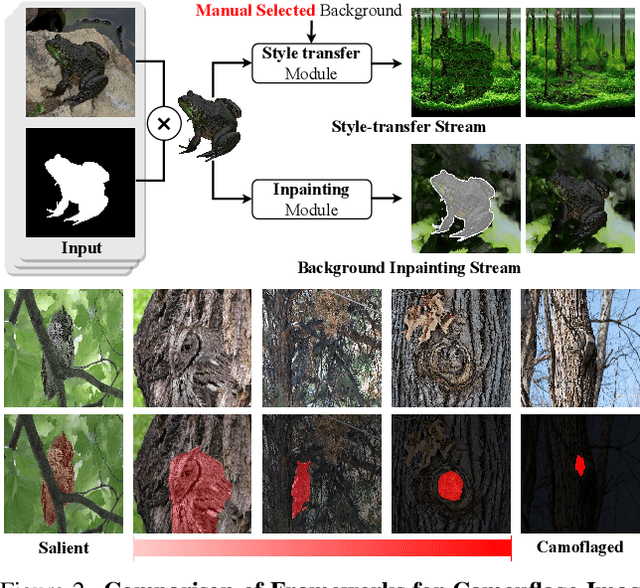

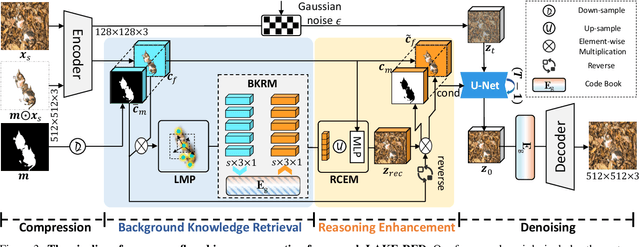
Abstract:Camouflaged vision perception is an important vision task with numerous practical applications. Due to the expensive collection and labeling costs, this community struggles with a major bottleneck that the species category of its datasets is limited to a small number of object species. However, the existing camouflaged generation methods require specifying the background manually, thus failing to extend the camouflaged sample diversity in a low-cost manner. In this paper, we propose a Latent Background Knowledge Retrieval-Augmented Diffusion (LAKE-RED) for camouflaged image generation. To our knowledge, our contributions mainly include: (1) For the first time, we propose a camouflaged generation paradigm that does not need to receive any background inputs. (2) Our LAKE-RED is the first knowledge retrieval-augmented method with interpretability for camouflaged generation, in which we propose an idea that knowledge retrieval and reasoning enhancement are separated explicitly, to alleviate the task-specific challenges. Moreover, our method is not restricted to specific foreground targets or backgrounds, offering a potential for extending camouflaged vision perception to more diverse domains. (3) Experimental results demonstrate that our method outperforms the existing approaches, generating more realistic camouflage images.
AdapEdit: Spatio-Temporal Guided Adaptive Editing Algorithm for Text-Based Continuity-Sensitive Image Editing
Dec 24, 2023Abstract:With the great success of text-conditioned diffusion models in creative text-to-image generation, various text-driven image editing approaches have attracted the attentions of many researchers. However, previous works mainly focus on discreteness-sensitive instructions such as adding, removing or replacing specific objects, background elements or global styles (i.e., hard editing), while generally ignoring subject-binding but semantically fine-changing continuity-sensitive instructions such as actions, poses or adjectives, and so on (i.e., soft editing), which hampers generative AI from generating user-customized visual contents. To mitigate this predicament, we propose a spatio-temporal guided adaptive editing algorithm AdapEdit, which realizes adaptive image editing by introducing a soft-attention strategy to dynamically vary the guiding degree from the editing conditions to visual pixels from both temporal and spatial perspectives. Note our approach has a significant advantage in preserving model priors and does not require model training, fine-tuning, extra data, or optimization. We present our results over a wide variety of raw images and editing instructions, demonstrating competitive performance and showing it significantly outperforms the previous approaches.
Emotion Recognition from Multiple Modalities: Fundamentals and Methodologies
Aug 18, 2021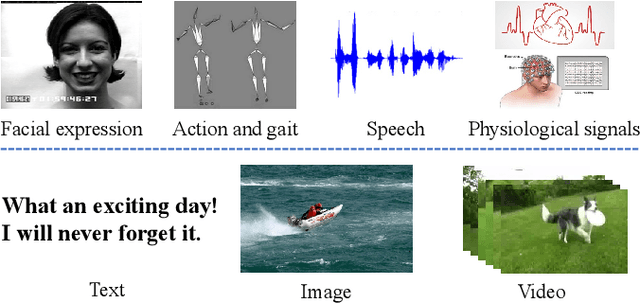

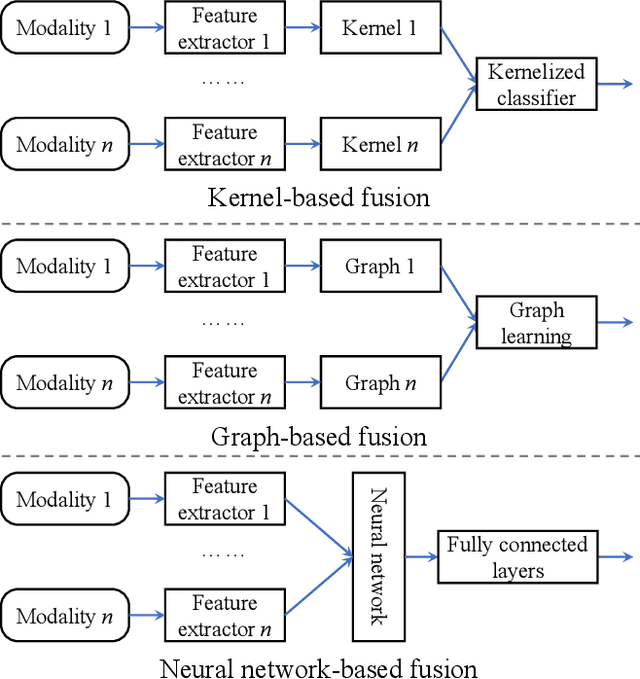
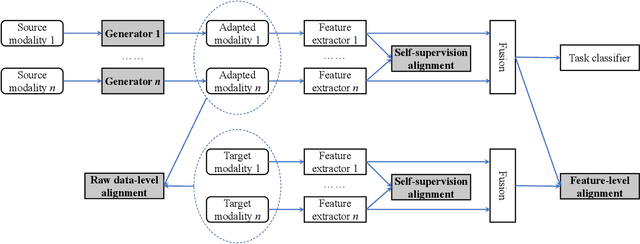
Abstract:Humans are emotional creatures. Multiple modalities are often involved when we express emotions, whether we do so explicitly (e.g., facial expression, speech) or implicitly (e.g., text, image). Enabling machines to have emotional intelligence, i.e., recognizing, interpreting, processing, and simulating emotions, is becoming increasingly important. In this tutorial, we discuss several key aspects of multi-modal emotion recognition (MER). We begin with a brief introduction on widely used emotion representation models and affective modalities. We then summarize existing emotion annotation strategies and corresponding computational tasks, followed by the description of main challenges in MER. Furthermore, we present some representative approaches on representation learning of each affective modality, feature fusion of different affective modalities, classifier optimization for MER, and domain adaptation for MER. Finally, we outline several real-world applications and discuss some future directions.
Affective Image Content Analysis: Two Decades Review and New Perspectives
Jun 30, 2021
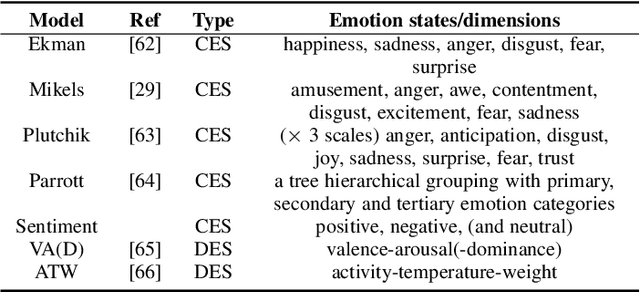
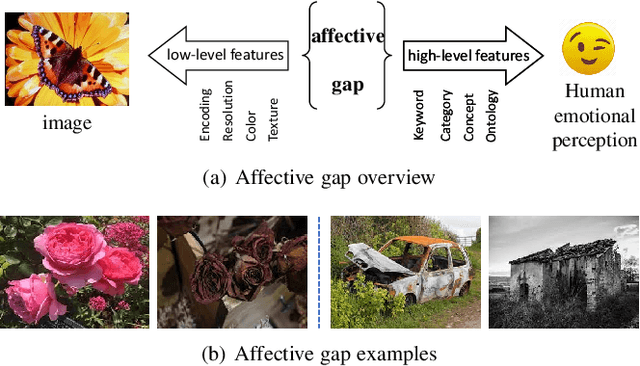

Abstract:Images can convey rich semantics and induce various emotions in viewers. Recently, with the rapid advancement of emotional intelligence and the explosive growth of visual data, extensive research efforts have been dedicated to affective image content analysis (AICA). In this survey, we will comprehensively review the development of AICA in the recent two decades, especially focusing on the state-of-the-art methods with respect to three main challenges -- the affective gap, perception subjectivity, and label noise and absence. We begin with an introduction to the key emotion representation models that have been widely employed in AICA and description of available datasets for performing evaluation with quantitative comparison of label noise and dataset bias. We then summarize and compare the representative approaches on (1) emotion feature extraction, including both handcrafted and deep features, (2) learning methods on dominant emotion recognition, personalized emotion prediction, emotion distribution learning, and learning from noisy data or few labels, and (3) AICA based applications. Finally, we discuss some challenges and promising research directions in the future, such as image content and context understanding, group emotion clustering, and viewer-image interaction.
 Add to Chrome
Add to Chrome Add to Firefox
Add to Firefox Add to Edge
Add to Edge